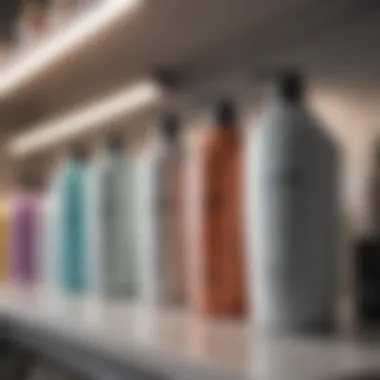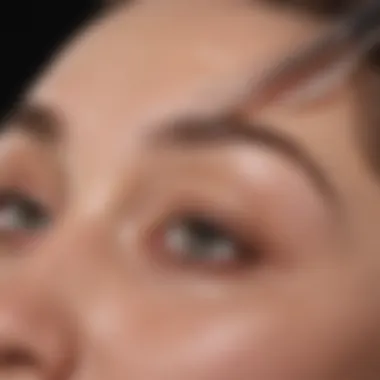Effective Strategies for Removing Dandruff Flakes


Intro
Dandruff presents an issue that many grapple with, regardless of age or background. This condition can lead to significant embarrassment and may even affect self-esteem. It is characterized by visible flakes that can be observed on the scalp and hair, often accompanied by itching. Understanding the root causes of dandruff is important. Factors may include dry skin, oily skin, food sensitivities, or even certain skin conditions like psoriasis.
This article endeavors to present effective strategies for managing and removing dandruff flakes from hair. In the following sections, we will explore various solutions, including natural remedies, as well as the best commercial products available on the market. By the end of this guide, readers will be armed with the knowledge necessary to tackle this common but bothersome condition.
Effective Treatments
Natural Remedies
Natural remedies often appeal to those seeking gentle alternatives to commercial products. Potential methods include:
- Tea Tree Oil: Known for its antifungal properties, tea tree oil can help in reducing dandruff. Mixing a few drops with a carrier oil before application is recommended.
- Apple Cider Vinegar: Its acidic nature may balance the pH of the scalp. Diluting with water and applying as a rinse can offer relief.
- Coconut Oil: This moisturizing oil can combat dryness. Massaging coconut oil into the scalp could provide dual benefits of hydration and dandruff reduction.
Commercial Products
For those who prefer scientifically-formulated solutions, there are many products specifically designed to tackle dandruff. Look for ingredients such as:
- Pyrithione Zinc: Found in shampoos like Head & Shoulders, it targets the fungus that causes dandruff.
- Ketoconazole: Present in products like Nizoral, it's a strong antifungal that can assist in managing severe cases.
- Salicylic Acid: This ingredient helps by exfoliating the scalp and removing flaky skin, often found in products like Neutrogena T/Sal.
Lifestyle Adjustments
Making small lifestyle changes can significantly impact the scalp's health. Key considerations include:
- Diet: Eating a balanced diet rich in omega-3 fatty acids may promote scalp health. Foods such as fish, nuts, and seeds are recommended.
- Hydration: Staying adequately hydrated supports overall skin health, including the scalp.
- Stress Reduction: High stress can contribute to skin issues, including dandruff. Practices such as meditation or regular exercise can help in managing stress levels.
"Incorporating both natural remedies and commercial treatments provides a holistic approach to dandruff management."
The End
Successfully addressing dandruff involves a blend of treatments, both natural and commercial. Identifying the specific cause and adjusting one’s lifestyle are essential steps. With the right strategies in hand, it is possible to regain a healthy scalp and enjoy flake-free hair. Readers are encouraged to experiment with different methods to find what works best for them.
Understanding Dandruff
Dandruff is a condition that can significantly affect one's comfort and confidence. Understanding it is crucial as it lays the foundation for effective treatment strategies. The more knowledge one has about dandruff, the better equipped they are to choose suitable solutions. This section aims to provide clarity on what dandruff is, its underlying causes, and how it manifests in different populations.
What is Dandruff?
Dandruff is a common scalp condition characterized by flaking of the skin. These flakes can be white or yellowish and may vary in size. Dandruff may be accompanied by itching and irritation, impacting daily routines and social interactions. It is not just a cosmetic issue but can also indicate an underlying irritation of the skin. People often misconceive dandruff as a simple problem of hygiene. However, its causes can be multifaceted, requiring more than just increased washing.
Causes of Dandruff
The causes of dandruff can be diverse. One of the primary factors is the overgrowth of a yeast-like fungus known as Malassezia. This organism naturally occurs on the scalp but, under certain conditions, it can lead to increased cell turnover. Factors contributing to excess Malassezia sometimes include stress, hormonal changes, and diet.
Other factors worth noting are dry skin, sensitivity to hair products, and specific skin conditions such as eczema or psoriasis. Hormones have an important role too. For instance, dandruff is often more prevalent during adolescence due to hormonal fluctuations. Moreover, environmental factors can play a part as well; cold, dry weather may worsen the condition.
Prevalence and Demographics
Dandruff is a widespread condition affecting individuals across all age groups and demographics. Estimates suggest that approximately 50% of adults experience some degree of dandruff in their lifetime. It is more common in men than in women, likely due to hormonal and biological differences. Though it can occur in any ethnicity, variations in diet and weather can influence its prevalence among certain populations.
In summary, understanding dandruff involves recognizing its definition, identifying the causes, and acknowledging its prevalence. This knowledge is essential for individuals seeking effective solutions.
Recognizing Symptoms
Understanding the symptoms of dandruff is crucial for effective management. This knowledge helps individuals identify the condition early and choose the appropriate actions to alleviate the discomfort associated with it. Often, flakes alone do not tell the full story. Recognizing accompanying symptoms can lead to more targeted solutions.
Characteristics of Dandruff Flakes
Dandruff flakes come in various sizes and colors. Most commonly, they appear as white or yellowish flakes that can be seen on the scalp, shoulders, or within the hair. The size can range from small, pin-sized specks to larger, quarter-sized pieces. The appearance can vary among individuals, depending on the scalp condition and severity.
It is also important to observe whether the flakes are oily or dry. Oily flakes tend to stick to the scalp and can create a greasy appearance. Dry flakes are usually more dusty and fall off easily.
Additionally, individuals may notice an increase in flaking in certain environments, such as dry indoor settings or during seasonal changes. This variability highlights how the surrounding conditions can affect the scalp health and thus the visibility of dandruff.


Itching and Irritation
Alongside visible flakes, itching is a significant symptom of dandruff. An irritated scalp can lead to scratching, which may worsen the condition. The urge to scratch can be intense and is often triggered by dryness or the irritation caused by the flakes themselves.
This sensation can vary among individuals. Some may experience a mild itch, while others may find it painful. The irritation often exacerbates the visibility of dandruff and can lead to a cycle where scratching causes more flakes and increased discomfort.
Keeping track of when itching occurs can be useful for identifying potential triggers. Factors such as stress, dietary changes, or weather conditions can influence the intensity of the symptoms. Recognizing these patterns allows individuals to address underlying causes while also managing the visibility of dandruff more effectively.
"Identifying the symptoms is vital for effective dandruff management. Understanding both flakes and irritation contributes to finding suitable solutions."
In summary, recognizing the symptoms of dandruff—characteristics of the flakes and the accompanying itching—is fundamental. By doing so, one can make informed decisions about treatment and lifestyle modifications to alleviate the condition. This awareness sets the stage for exploring further strategies for effectively removing dandruff flakes.
Personal Hair Care Practices
Personal hair care practices are fundamental in the pursuit of managing dandruff effectively. Beyond merely addressing the visible symptoms, these practices create an environment conducive to scalp health, thus reducing the likelihood of dandruff recurrence. It applies to everyone, whether you occasionally experience flakes or deal with persistent issues. The right techniques can significantly influence your scalp condition.
Choosing the Right Shampoo
Selecting the right shampoo is crucial for dandruff management. Not all shampoos are created equal, and understanding the ingredients can make a notable difference. Anti-dandruff shampoos typically contain active compounds such as zinc pyrithione, selenium sulfide, or ketoconazole. These ingredients target the yeast that contributes to dandruff.
When examining shampoos, always read the label. You may want to try different products to find what works best for your hair type. Avoid tempting scents that may irritate the scalp or cause allergic reactions. It can be beneficial to alternate between anti-dandruff shampoos to prevent resistance.
Regular Washing Techniques
Regular washing is essential in combating dandruff. It helps to remove excess oil, dirt, and dead skin cells that can contribute to flaking. However, one must strike a balance; over-washing may strip oils and lead to dryness.
For effective washing:
- Use lukewarm water when wetting the hair.
- Massage the scalp gently with fingertips to boost circulation.
- Prioritize thorough rinsing to eliminate all traces of shampoo and conditioner.
These practices help maintain a clean scalp and encourage hair health.
Proper Conditioning Methods
Conditioning plays a vital role in maintaining moisture levels in the hair and scalp. A well-hydrated scalp is less prone to the irritation and dryness that often lead to dandruff. Choose a conditioner designed for your specific hair type and focus on applying it to the ends of the hair rather than the scalp.
For those struggling with dandruff, consider leave-in conditioners with nourishing ingredients that do not leave a heavy residue. Additionally, it could be helpful to limit the use of styling products that can build up on the scalp and exacerbate dandruff.
Maintaining a consistent hair care routine not only supports hair and scalp health but also enhances your overall appearance.
By integrating these personal hair care practices into your routine, you can take significant strides toward managing dandruff flakes effectively.
Natural Remedies
Natural remedies play a significant role in the management of dandruff. These solutions often use ingredients readily available at home, making their application practical and accessible. Many individuals gravitate towards natural treatments due to the perception that they are safer and less irritating than commercial products. On top of this, natural remedies can address the root causes of dandruff, leading to long-term benefits, rather than just short-term relief.
The efficacy of these remedies does not only depend on their active ingredients but also on how consistently they are applied. Unlike instant solutions, natural methods require patience and dedication. However, many find the journey rewarding, as these remedies typically combine nourishing properties not just for the scalp but for overall hair health.
Essential Oils for Dandruff
Essential oils can serve as effective treatments for dandruff due to their antifungal and soothing properties. Each oil has unique attributes that can specifically aid scalp health. For example, tea tree oil contains antifungal compounds that fight the fungus Malassezia, a key contributor to dandruff. Lavender oil promotes relaxation and scalp circulation while also containing antimicrobial properties.
To use essential oils, mix a few drops with a carrier oil such as coconut or olive oil. An alternative approach is to add essential oils to your regular shampoo. A patch test is recommended before applying any essential oil to ensure no adverse skin reactions occur.
Home-Made Treatments
Making home-made treatments for dandruff can be both cost-effective and satisfying. Here are a few recipes that many have found helpful:
- Apple Cider Vinegar Rinse: Combine equal parts apple cider vinegar and water. After washing your hair, apply the mixture, leave it on for a few minutes, then rinse. The acidity of vinegar may help restore scalp pH balance.
- Aloe Vera Gel: Apply pure aloe vera gel directly onto the scalp. Leave it for about 30 minutes before shampooing. Aloe vera has anti-inflammatory properties which can soothe irritation and reduce flakes.
- Yogurt Mask: Apply plain yogurt to the scalp and leave it for 30 minutes. The probiotics in yogurt can help in balancing the scalp microbiome.
These treatments require regular use for optimal results. Undoubtedly, the tactile experience of creating your remedies can be part of the enjoyment.
Dietary Considerations
Diet plays an essential role in maintaining scalp health and reducing dandruff. A well-balanced diet can support healthy skin and hair. Foods rich in omega-3 fatty acids, such as salmon, walnuts, and flaxseeds, promote scalp hydration, reducing dryness.


Incorporating fruits and vegetables high in antioxidants can help combat inflammation. Dark leafy greens, berries, and citrus fruits can provide the necessary vitamins for a healthy scalp.
Hydration is also vital; drinking adequate water helps maintain the moisture balance in the skin. Avoiding excessive sugar and processed foods may also contribute to better scalp condition. Consider keeping a food diary to identify any potential food triggers for your dandruff.
"An effective strategy for combating dandruff involves a holistic approach: combine natural remedies with a balanced diet for better results."
Over-the-Counter Solutions
In addressing dandruff, over-the-counter solutions play a critical role. They offer accessible options for individuals seeking to manage and effectively remove flakes from their hair without needing a prescription. Understanding these solutions can empower consumers to make informed decisions regarding their hair care. Dandruff can stem from various causes, such as dry skin, yeast-like fungus, or sensitivity to hair care products. Therefore, products that specifically target these issues can aid in alleviating symptoms and restoring a healthy scalp.
Anti-Dandruff Shampoos
Anti-dandruff shampoos are perhaps the most recognized over-the-counter solution. These shampoos contain active ingredients designed to combat the root causes of dandruff. Common ingredients include pyrithione zinc, ketoconazole, coal tar, and salicylic acid. Each ingredient works differently:
- Pyrithione Zinc: This is effective against fungi and bacteria, reducing scalp irritation.
- Ketoconazole: It is an antifungal ingredient that can be useful for severe dandruff cases.
- Coal Tar: This often reduces skin cell turnover, preventing the buildup associated with dandruff.
- Salicylic Acid: This helps to exfoliate the scalp, easing the removal of flakes.
When choosing an anti-dandruff shampoo, it’s essential to consider the scalp type. For instance, individuals with oily scalps may benefit from higher concentrations of these active ingredients, while those with dry scalps should opt for gentler formulas. Regular use can lead to noticeable improvements, but it may take several weeks to observe the full effects. It is equally important to follow the instructions on the label to achieve optimal results.
Topical Treatments
While shampoos serve as the first line of defense against dandruff, topical treatments can complement these efforts. These products include lotions, creams, and scalp sprays, which can be applied directly to the affected areas. They are beneficial in addressing more localized dandruff issues.
The effectiveness of topical treatments often hinges on specific active ingredients. Here are some common examples:
- Benzoyl Peroxide: This can help reduce itchiness and eliminate flakes on the scalp.
- Tea Tree Oil: Known for its antimicrobial properties, it can soothe inflammation and promote a balanced scalp.
- Corticosteroids: These can be useful in managing inflammation associated with severe scalp conditions.
Choosing a topical treatment involves understanding the type of dandruff one is experiencing. For example, inflammatory dandruff may respond well to corticosteroids, while fungal issues might improve with treatments containing tea tree oil. However, users should be aware of the possibility of skin sensitivity and should perform patch tests when trying a new product.
Regular consultation with a healthcare professional is recommended for chronic dandruff issues.
Medical Intervention
Dandruff can often be a benign annoyance, yet, in some cases, it may indicate underlying dermatological issues. Medical intervention becomes crucial when over-the-counter treatments do not yield satisfactory results. Seeking professional help allows individuals to understand their specific condition better and receive tailored recommendations that address their unique needs.
The benefits of medical intervention are substantial. Dermatologists have specialized knowledge and training that enable them to identify conditions that may mimic or accompany dandruff, such as seborrheic dermatitis or psoriasis. Through thorough evaluations, they can prescribe treatments that are more effective than standard shampoos or topical treatments.
Considerations for medical intervention also encompass understanding the various prescription options available. These medications often contain active ingredients targeting the root cause of dandruff and its symptoms. Understanding the short and long-term implications of each treatment can help ensure successful management of the condition.
Consulting a Dermatologist
When dandruff persists or worsens despite attempts to manage it, consulting a dermatologist becomes imperative. A dermatologist can evaluate the scalp and skin condition comprehensively. This evaluation can reveal useful information regarding causes that may range from skin types to possible allergies.
During the consultation, the dermatologist will likely inquire about personal hair care routines, diet, and stress levels, offering a holistic view of the patient’s lifestyle. Oftentimes, lab tests may be conducted to rule out more serious conditions. This ensures that the treatment plan devised is custom-fit to the individual.
Seek a consultation if you notice the following symptoms:
- Persistent flaking that does not improve with usual treatments
- Redness or irritation on the scalp
- Changes in hair health, like hair thinning or loss
An informed and professional assessment not only targets symptoms effectively but also helps resolve issues that may not be apparent on the surface.
Prescription Options
Once a diagnosis is established, the dermatologist can recommend prescription options tailored to individual needs. These options may include stronger antifungal medications, corticosteroid lotions, or specialized cleansing treatments. These products often contain higher concentrations of active ingredients compared to over-the-counter alternatives, making them more effective for stubborn cases of dandruff.
Common prescription treatments include products with active ingredients like ketoconazole, ciclopirox, or zinc pyrithione. These actively address fungal growth over the scalp. Corticosteroids may be prescribed to reduce inflammation and itching. However, while medications can effectively treat symptoms, it is critical to follow the prescribed regimen closely to avoid potential side effects or resistance over time.
It is also important to follow up with the dermatologist to assess the effectiveness of the treatment. Regular assessments allow any necessary adjustments to the plan, ensuring that the individual receives the most effective treatment over time.
"Medical intervention in dandruff management is not merely about treating symptoms; it is a comprehensive approach to understanding the root causes that can make all the difference in the long run."
Engaging in medical interventions can provide clarity and effective solutions – leading not just to improved scalp health but also to greater confidence in one’s appearance.
Preventative Strategies
Preventative strategies play a pivotal role in managing dandruff. Understanding that prevention is often easier than treatment can help individuals take proactive measures. By maintaining a healthy scalp and recognizing potential triggers, many people can significantly reduce the occurrence of dandruff. A consistent routine emphasizing cleanliness and moisturizing is essential. In addition, being aware of lifestyle factors that contribute to dandruff can lead to more effective management.


Maintaining Scalp Health
Maintaining scalp health is crucial for preventing dandruff. A healthy scalp not only reduces the appearance of flakes but also enhances overall hair quality. Regular cleansing is essential to remove excess oils and prevent the buildup of dead skin cells. Choosing a mild, sulfate-free shampoo can help in avoiding irritation. As part of a routine, gentle massaging of the scalp while washing can stimulate circulation and promote healthy skin.
Moreover, moisturizing is equally vital. Dry scalp can lead to flaking, hence using natural oils like coconut or jojoba oil can provide the necessary hydration. Applying these oils for a brief period before washing can help keep the scalp nourished. Environment also plays a role; avoiding overly dry air during winter months can make a difference. Humidifiers may be helpful in such cases, keeping the scalp adequately hydrated.
Recognizing Triggers and Avoiding Them
Triggers can vary widely between individuals, but recognizing them is a key strategy for preventing dandruff. Common triggers include stress, certain foods, and environmental factors. Stress can exacerbate skin conditions, causing increased flaking. Therefore, implementing stress management techniques such as meditation, exercise, or simple breathing exercises may reduce its impact on the scalp.
Dietary choices also affect scalp health. Some individuals may find that dairy or sugary foods worsen their dandruff. Monitoring and potentially eliminating these foods from one’s diet can be a proactive approach. Meanwhile, staying hydrated by drinking sufficient water can help maintain skin elasticity, contributing to a healthier scalp.
Lifestyle Modifications
Lifestyle modifications play a crucial role in managing and removing dandruff flakes. These changes can significantly affect scalp health and overall hair condition. By addressing lifestyle choices, individuals often experience a reduction in the frequency and severity of dandruff. Small adjustments can yield substantial benefits, impacting both self-esteem and comfort levels.
Stress Management Techniques
Stress is a known trigger for dandruff. High stress levels can worsen existing skin conditions, leading to increased flakiness, itching, and irritation. Implementing effective stress management techniques can help mitigate these issues.
Consider practices such as mindfulness and meditation. These methods have been shown to reduce stress levels over time. Physical activities, such as yoga and regular exercise, also contribute to lower cortisol levels, enhancing emotional well-being. Simple breathing exercises can serve as immediate relief during stressful moments.
Additionally, maintaining time for hobbies and relaxation can foster positive mental health, making it easier to manage the daily pressures that might contribute to dandruff.
Hydration and Nutrition
Proper hydration and nutrition are fundamental for sustainable scalp health. Drinking sufficient water helps maintain skin moisture and prevents dryness, which can exacerbate dandruff. Aim to drink at least eight glasses of water each day.
Diet also plays a significant role in scalp condition. Foods rich in omega-3 fatty acids, such as salmon and walnuts, promote scalp hydration and reduce inflammation. Incorporating a variety of fruits and vegetables ensures a rich intake of vitamins and minerals crucial for skin health. Specific nutrients like zinc and B vitamins have been associated with managing dandruff effectively.
A balanced diet not only nourishes the body but can also reflect positively on your scalp and hair health.
By making these lifestyle modifications, one can enhance the management of dandruff, leading to healthier hair and a more confident self-image.
Debunking Common Myths
The topic of myths surrounding dandruff is essential to understand for anyone dealing with this condition. These misconceptions can lead individuals to ineffective treatments and may even worsen their scalp issues. It is vital to distinguish between fact and fiction, as misinformed choices can complicate the problem and promote frustration. Addressing these myths not only helps in managing dandruff effectively but also saves time and resources that may be wasted on useless remedies.
Myths Surrounding Dandruff
Many people hold various beliefs about dandruff and its treatment. One prevalent myth is that dandruff is solely caused by poor hygiene. While hygiene plays a role, it is not the only or primary cause. Factors like dryness, sensitivity to hair products, and even medical conditions contribute to the problem.
Another common misconception is that more frequent washing can eliminate dandruff. In fact, washing hair too often may strip the scalp of its natural oils, leading to dryness and the production of even more flakes. Additionally, some believe that dandruff is solely a winter problem. This belief disregards the fact that many experience dandruff year-round due to various triggers.
Finally, people often think that using multiple products at once will yield better results. This approach can backfire, leading to scalp irritation and confusion about which product actually works.
Truth Behind Dandruff-Specific Products
When it comes to dandruff-specific products, individuals may wonder if they need to invest heavily in these solutions. Some believe that only expensive brands are effective. However, many affordable options like Head & Shoulders and Neutrogena offer proven results with active ingredients that target dandruff effectively.
It is important to understand that not every product is suitable for all types of dandruff. For instance, dandruff caused by a yeast-like fungus may require antifungal shampoos such as those with ketoconazole or selenium sulfide. On the other hand, psoriasis may need a completely different treatment approach.
Additionally, while some shampoos claim to eliminate dandruff completely, it is crucial to remember that effective management often requires consistent use. Switching products too frequently can disrupt the scalp’s balance, making it challenging to identify what really works.
"Understanding the myths and truths about dandruff can empower individuals to make informed choices about their hair care routines."
In summary, debunking common myths about dandruff and its specific products equips individuals with the knowledge necessary to make better treatment decisions. Avoiding misconceptions empowers readers to choose effective solutions tailored to their needs.
The End
Dandruff is more than a cosmetic concern; it can affect one’s confidence and self-esteem. As discussed throughout this article, understanding the various methods for removing dandruff flakes is essential for effective management. A holistic approach that includes personal hair care practices, natural remedies, over-the-counter solutions, and potential medical interventions can make a significant difference.
Summarizing Effective Strategies
In summary, the effective strategies for removing dandruff flakes involve multiple facets:
- Proper Hair Care: Regular washing with a suitable shampoo helps to remove excess oil and dead skin cells. It is crucial to choose products specifically formulated for dandruff.
- Natural Remedies: Utilizing essential oils, such as tea tree or peppermint oil, can provide relief and reduce flaking. Homemade treatments may also offer effective solutions without harsh chemicals.
- Lifestyle Considerations: Stress management and adequate hydration play a role in scalp health. Recognizing personal triggers and adjusting habits can significantly improve the condition.
- Medical Options: For persistent cases, consulting a dermatologist is vital. Prescription treatments can target underlying issues that over-the-counter products might not address.
By adopting these strategies, individuals can gain a better grip on their dandruff issues. It is important to remember that results may vary and finding the right combination of methods often requires patience.
"Dandruff is common, but with the right approach, it is manageable."















